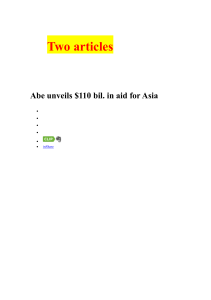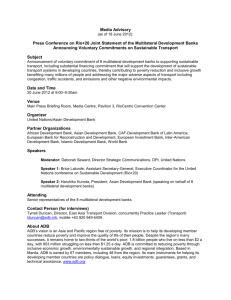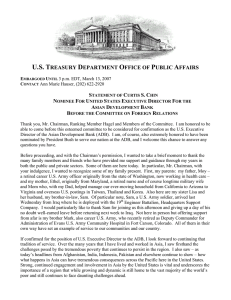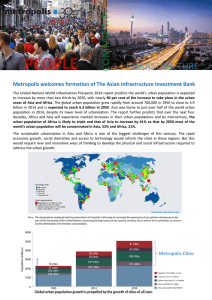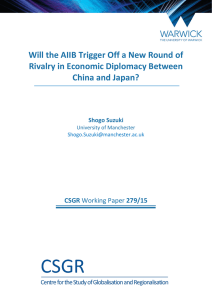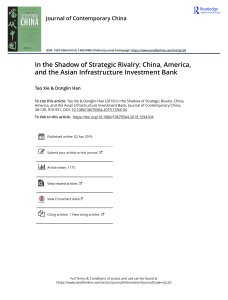1/29/15 With two major announcements on trade and climate at November’s... Scott Morris
advertisement
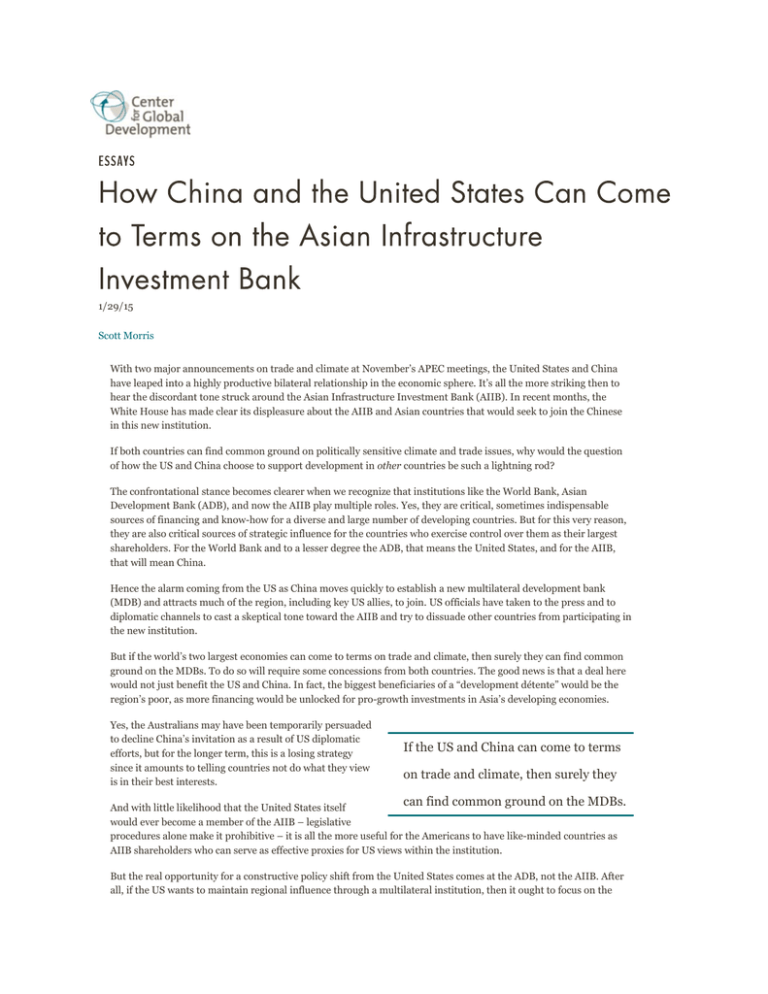
1/29/15 Scott Morris With two major announcements on trade and climate at November’s APEC meetings, the United States and China have leaped into a highly productive bilateral relationship in the economic sphere. It’s all the more striking then to hear the discordant tone struck around the Asian Infrastructure Investment Bank (AIIB). In recent months, the White House has made clear its displeasure about the AIIB and Asian countries that would seek to join the Chinese in this new institution. If both countries can find common ground on politically sensitive climate and trade issues, why would the question of how the US and China choose to support development in other countries be such a lightning rod? The confrontational stance becomes clearer when we recognize that institutions like the World Bank, Asian Development Bank (ADB), and now the AIIB play multiple roles. Yes, they are critical, sometimes indispensable sources of financing and know-how for a diverse and large number of developing countries. But for this very reason, they are also critical sources of strategic influence for the countries who exercise control over them as their largest shareholders. For the World Bank and to a lesser degree the ADB, that means the United States, and for the AIIB, that will mean China. Hence the alarm coming from the US as China moves quickly to establish a new multilateral development bank (MDB) and attracts much of the region, including key US allies, to join. US officials have taken to the press and to diplomatic channels to cast a skeptical tone toward the AIIB and try to dissuade other countries from participating in the new institution. But if the world’s two largest economies can come to terms on trade and climate, then surely they can find common ground on the MDBs. To do so will require some concessions from both countries. The good news is that a deal here would not just benefit the US and China. In fact, the biggest beneficiaries of a “development détente” would be the region’s poor, as more financing would be unlocked for pro-growth investments in Asia’s developing economies. Yes, the Australians may have been temporarily persuaded to decline China’s invitation as a result of US diplomatic efforts, but for the longer term, this is a losing strategy since it amounts to telling countries not do what they view is in their best interests. If the US and China can come to terms on trade and climate, then surely they can find common ground on the MDBs. And with little likelihood that the United States itself would ever become a member of the AIIB – legislative procedures alone make it prohibitive – it is all the more useful for the Americans to have like-minded countries as AIIB shareholders who can serve as effective proxies for US views within the institution. But the real opportunity for a constructive policy shift from the United States comes at the ADB, not the AIIB. After all, if the US wants to maintain regional influence through a multilateral institution, then it ought to focus on the regional development bank where it already has influence. To put it bluntly, the US strategic aim should be to ensure that the AIIB does not eclipse the ADB, something that can be achieved not by criticizing the AIIB, but by making the ADB as attractive and robust in the region as possible. Even better, a pro-ADB strategy is something the Chinese will likely embrace. They have demonstrated through their own engagement with the bank that the regional choice does not need to be ADB or AIIB. It can and should be both. So what would make for a more attractive ADB? Perhaps more than anything else, more capital. Fortunately, the United States will have an opportunity over the next few years to lead a capital-raising effort at no new cost to US taxpayers. The US stands to “save” about $60 million a year as a donor to the ADB’s grant-making activities as a result of the bank’s pending financial reforms. Rather than pocketing that money, why not put it to use as new “paid in” capital in the bank? Combined with other countries’ contributions to a capital increase and the leverage of the ADB’s own borrowing, that $60 million could boost the bank’s infrastructure investment capacity by about $5 billion annually in just five years. The United States could also ease tensions with the Chinese by dropping the wrongheaded drive to kick China out of the ADB’s club of borrowers. The bank’s lending to China actually delivers financial stability to the institution and serves as a useful market test of the ADB’s products and services. After all, China, more than any other country in the region, has options when it comes to development finance. The bank’s efforts to remain attractive to the Chinese, particularly when it comes to technical assistance and knowledge products, are a useful discipline and motivator for the institution that ultimately benefits all ADB borrowers. While the United States has some work to do at the ADB, China in turn could move quickly to make a number of constructive overtures at the AIIB. These actions are less about making concessions to the US than demonstrating a desire to have the AIIB operate as a peer within the existing MDB system by adopting key principles, norms, and values that are firmly established at the World Bank and ADB. First, China’s advertised 50 percent shareholding is far too much for any one country in a multilateral institution. The US is widely characterized as dominating the World Bank, yet its shareholding there is just over 15 percent. China and other emerging market countries have been rightly frustrated by the slow pace of shareholding reform at the IMF and World Bank, but China’s shareholding stance at the AIIB undercuts its principled arguments on governance at the other institutions. Specifically, by signing on to the IMF-World Bank debt sustainability framework, the AIIB would demonstrate its willingness to operate within international principles aimed at preventing unsustainable debt in developing countries. And when debt problems occur, there should be no doubt about the AIIB’s intention to work constructively alongside other multilateral and bilateral creditors toward resolutions. China in turn could move quickly to make a number of constructive overtures at the AIIB. China could also make straightforward commitments to universal and transparent procurement rules without adopting a line-by-line version of existing MDB rules. After all, the World Bank’s own procurement standards are in the midst of an overhaul, so the AIIB has no fixed target even if it wanted to adopt all of the existing rules. But a commitment to universal procurement would set a good tone by demonstrating that the AIIB is not intended to be an exclusive club for member countries’ commercial interests. Other areas of operational standards and safeguards are more challenging, and the Chinese would do well to avoid a wholesale adoption of existing MDB rules, even as they take steps to demonstrate a firm commitment to underlying principles. Like procurement, rules related to environmental and social standards are under active review at the existing MDBs, where more regulation over the years has too often been falsely equated with more effective standards. Starting with a clean slate, the AIIB has the opportunity to explore a new path for these standards. The new institution will be facing skeptics in the West when it comes to social and environmental issues, so the Chinese would do well to demonstrate a serious approach early on. There are a number of areas where the AIIB could usefully depart from the norms of the existing MDBs entirely. For example, would the Bretton Woods architects have so quickly established resident boards of directors, with annual costs in the tens of millions of dollars, in an era of instantaneous global communications? Chinese officials have already made broad-brush commitments to align the AIIB with existing MDB practices and standards. The difficult work of translating those commitments into detailed policies remains ahead. A key demonstration of good faith will be active consultation and engagement with the ADB and World Bank as policies are developed. With a development détente, the United States and China can add a third major outcome to their recent string of bilateral successes. Much like the climate agreement, coming to terms on the AIIB and ADB is not just about what is good for the US and China. It’s ultimately about how these two actors, working through multilateral institutions, can better serve the development aims of the global community.

